COSMIC WONDER Free Press
Awakening of Yama-kami
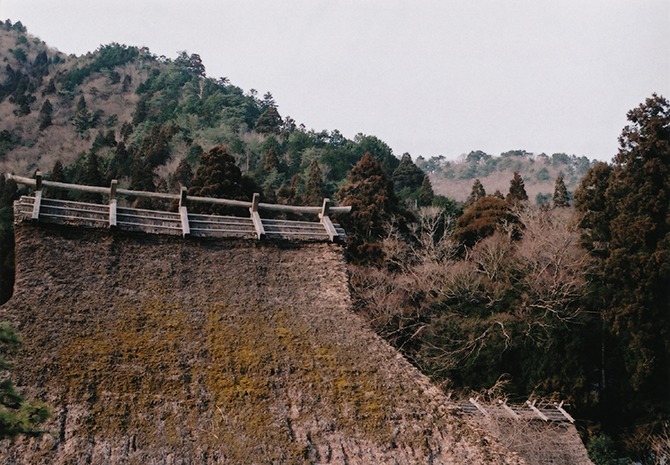
The Spring Snow of Utsukushiyama
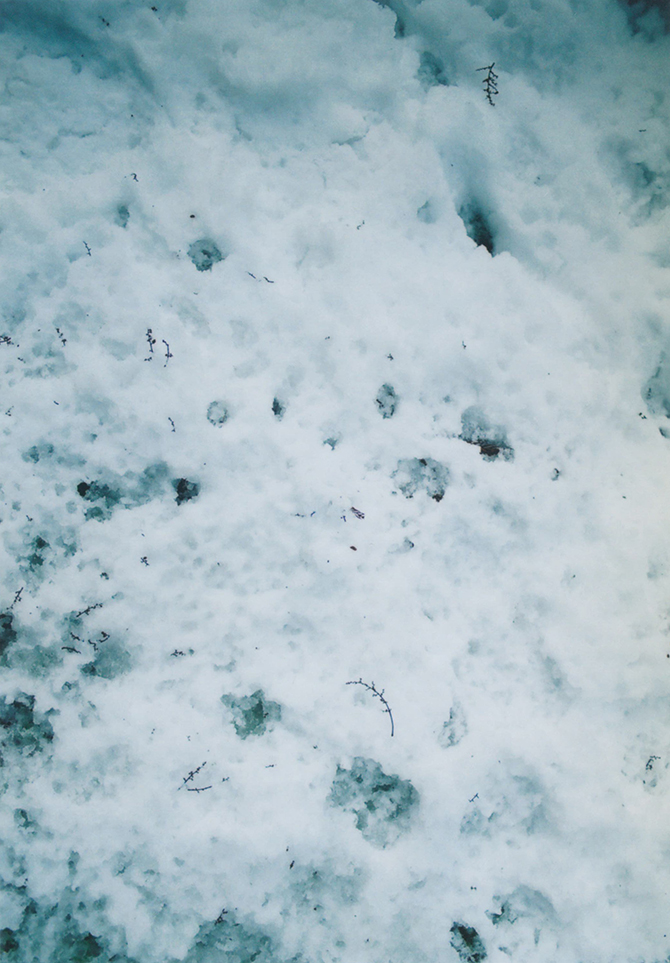
From the end of January to the beginning of the Lunar New Year, the village becomes covered in snow, giving rise to a beautiful white landscape.
This white world, as if trying to draw out something from within us, leads people engross themselves in tasks within the home.
Such environment is near that of death, and through strengthening the light of life amidst the silent calm, one continuously finds oneself in a daze-like sensation of reflecting and absorbing this luminance like sound.
Last year, the Ryugu where I live at the foothills of the mountains, had itself become reminiscent a snow hut due to the gusts of snow that had blown into the valley. I recall small wild animals going to and fro in the attic as the mountains and the thatched roof of the old house came to merge as one through the snowfall. This time around one must take effort so that the roof and mountains do not come together as one again.
I realize it has now been one year since I moved here. I have no sense of the time spent here being long or short, nor do I have an awareness of living in a place that is unknown to me. All I simply feel is the sense of me living here, in this very place, and for that I am grateful.
Venturing into the forests of Asei within the neighboring mountainous valleys on a deep snowy day like this, what would emerge before one’s eyes is a profoundly beautiful, white and unexplored land that is connected to the other world. One hopes to enter into such a forest one day.
My words may sound like those of a vexing literate, yet all I wish for is to purely witness this beautiful scene in nature.
When I come across the footsteps of some wild animal in the snow-covered mountains, I engage in playfully tracing their path. Depicted in that fleeting moment, are traces of people and animals coming together upon the snow.
January 22, 2018
With sincere gratitude for all the encounters and paths crossed in this village
Yukinori Maeda
from “Chii Ryugu Journal”
Photography by Ai Nakagawa
Translation by Kei Benger
HOUMOKUKI
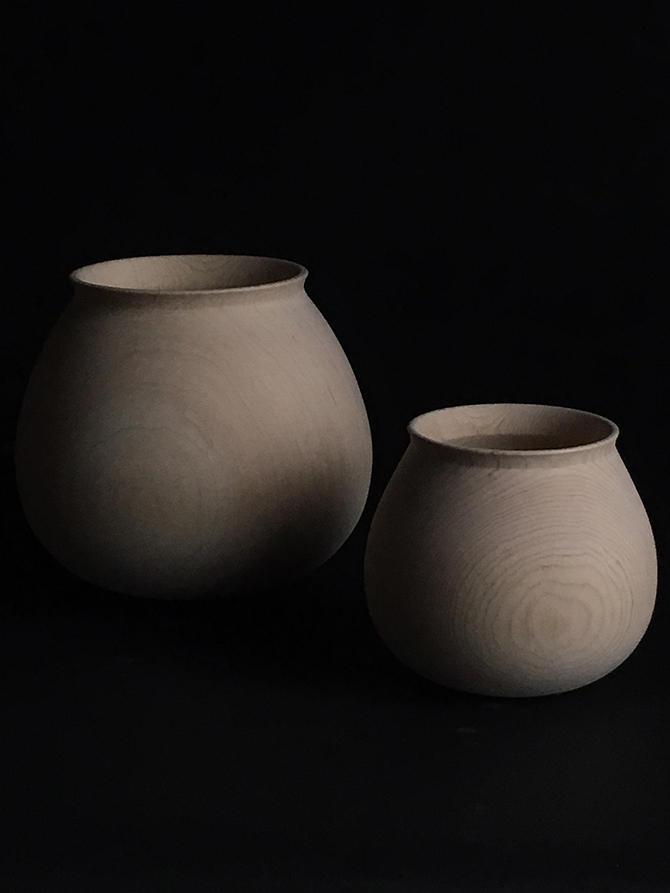
Masaru Kawai
Houmokuki 2017
Japanese cypress
The silent furnace of the unknown gives birth to a new light.
Vol.3
paper and crystal 2003
An eternal thing and a not eternal thing -for example, paper and crystal were placed
Well captain, what knows eternity?
I’ll take it on a ship.
All collection was made by paper, and attached flat cut crystal one by one. It doesn’t mean crystal is eternity and paper is not eternity, we want to make people feel everything is made, broken and gone that never remains in a moment.*
N.H: “Paper and Crystal” is a collection of clothing made of paper. Cosmic Wonder has also recently presented clothing called kamikoromo made of washi paper, which has been worn as garments for the “water ceremony” and “Omizue” (a ceremony for drinking spring water) I would like to ask you about the “Paper and Crystal” collection that you had presented back then. At the opening of the ‘You reach out –right now- for something: Questioning the Concept of Fashion’ exhibition, Susan Cianciolo had worn paper clothing that had been made by Cosmic Wonder at the time. I was deeply moved by this. I thought to myself, “so it really is possible to wear such clothes within the context of ordinary life.”
Y.M: (laughs) When we presented the collection at Paris Fashion Week, the next morning’s edition of the Liberation Newspaper had took half a page to feature photographs of these paper clothes. The fact that photographs of paper clothing were printed on paper in this way had amused me.
N.H: They have a completely different silhouette and sense of volume to that of fabric.
Y.M: In making them they had turned out more voluminous than I had thought. I have always been fond of crystals, and have continued to collect them. I am also very fond of printed matter and things that are made of paper. It was for this reason that I decided to bring the two things that I like together. The idea was initiated in this way, and I thought that it would be beautiful if I could create a contrast between the two. For the white clothes I used paper like you’d see in FedEx packaging, and for the other colored paper I used recycle paper. I would apply a core to the paper, or affix cloth from underneath so make it more durable and prevent it from tearing.
Forest Heights Lodge COSMIC WONDER 2004
The sun and the moon appear in your sky at the same time.
Equipment of Forest Heights Lodge COSMIC WONDER are nightwear for the daytime, sleeping bag for the daytime, pillow and bedcover for the daytime, picture for the daytime.*
N.H: Cosmic Wonder’s collections would greatly change its course here on after, moving towards the direction in which groups of men and women reside within a beautiful utopia. The first of such endeavors was Forest Heights Lodge Cosmic Wonder. Then it leads to magic village.
Y.M: I had been thinking about 9.11 for a long time. I was creating works while going back and forth between different elements, but I decided to slightly step away from the realm of personal expression. In terms of production I had always had a sense of admiration towards utopian places, freedom, and the spiritual world. It was just an issue of conveying it more clearly and in a visual way. Incorporating this interest towards the spiritual world into our works is something that we continue to do today, and we decided to move more and more in this direction. I feel that we have always fluctuated between two aspects that are, the aspect that focuses on creation, and the aspect of producing clothing that embody a spiritual impression but are comfortable to wear. I suppose that what has remained consistently unchanged is the way in which we create things with an awareness towards space.
N.H: Perhaps this fundamental approach will continue to remain unchanged, both now and into the future.
Y.M: Even though we had been thinking about and doing the same kind of thing since the beginning, it was from around this point in time when I began to consider presenting the sense of direction that I’m looking at more clearly, so that its evident to anyone who sees the work. I believe that one of the roles of art is to indicate which direction one is facing at that given moment.
N.H: Recently you have relocated both your studio and residence to Miyama. Is this because you imagine it as being a utopian setting of sorts? I see it as being a process within the context of your real life, in which the clothes in space, that is to say, the utopia that you had imagined, comes to manifest as reality.
Y.M: I hope to be able to engage in creation while having a deep understanding of spirituality.
Will it be possible to create something like this from living in the mountains?
Will leading a meditative life that lies close to nature, aid me in my way?
What will be born from this?
*The poetry texts are the concepts for each collection that were written at the time.
January 17, 2017
Nakako Hayashi and Yukinori Maeda
Traslator: Kei Benjer
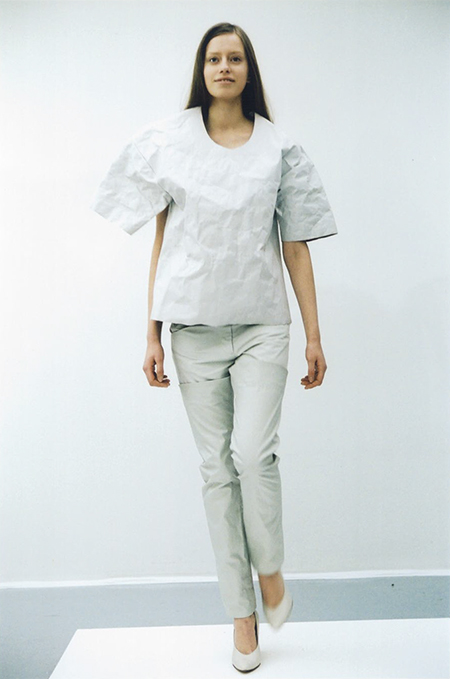
paper and crystal 2003
Photography by Shoji Fujii
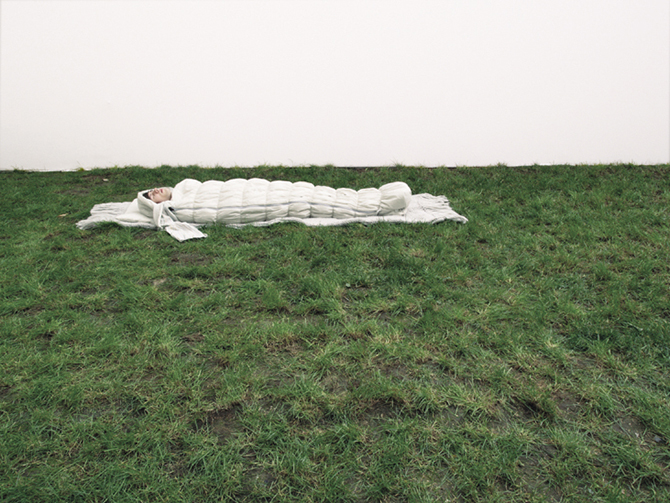
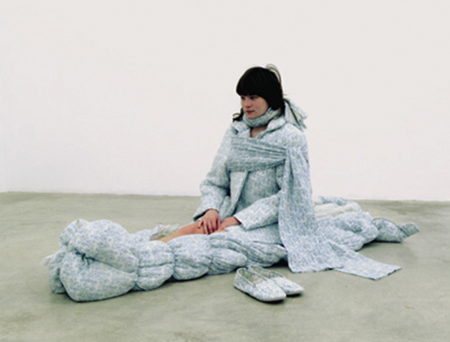
Forest Heights Lodge COSMIC WONDER 2004
Show at Cosmic gallery, Paris
Photography by Yuki Kimura
The silent furnace of the unknown gives birth to a new light.
Vol.2
to sleep 2002
Works in which hanger, drawer, necklace, dress, T-shirt or jacket are stuck together and completed. We make one by sticking easily the things that must not stick. Due to that, we create anew worth.*
A Shadow Necessary for Windows 2002
This is one of sight in my mind. Or it may be a common sight all of us have somewhere in our mind. It seems we have a time equivocal. People repeat that day after day. Where will we stop in the end? Or is there no end?
Curtain dress and dress to pause for it.*
What invisible view should be ~ from some pictures 2003
We reappear parts that can be seen in the picture, and remove what cannot be. The performance like that cut out from pictures floats in the space, and it comes into new existence and meanings that are different from that essentially recorded in the pictures.*
N.H: These works were produced during a time when you had engaged in a succession of artistic installations.
In “ to sleep,” various clothing were integrated with interior furnishings for example, a drawer and a dress, and a necklace and a coat hanger. In “A Shadow necessary for windows,” clothing and curtains are attached to each other, with fringes being arranged throughout. I am very fond of the installations you had presented during this period. The grey single-tone look had a very Cosmic Wonder feel, and I also liked how the fringe design had embodied a romantic element almost like a girl’s comic.
In “What invisible view should be,” the collection piece is a reproduction of the parts of the clothing that are visible in found photographs. What is in the shadows or outside of the image frame is deemed to not exist, and therefore the clothes consist solely of a particular part.
“A Shadow Necessary for Windows” had also caught me by surprise, but it also harbored unexpectedness in the fact that they were made of jersey material and cotton, and therefore could be worn more comfortably than one would have imagined. This collection however, had in a sense surpassed the level of surprised I had felt back then. They are clothes that cannot be worn on their own.
Y.M: There was a sense of interest in using things that are unpractical and had somehow been conceived as tools for a performance, within the context of the everyday.
N.H: This collection that seemingly presents us with a question, in my opinion, very much fits the nature of Cosmic Wonder. Was there anything that you had been intentionally conscious of in terms of the choice of images and composition?
Y.M: Instead of devising the clothes one by one individually, I had thought to create it in a way in which they would cohesively present a single impression.
N.H: It was also memorable that a poster had served as the collection’s invitation card, with the found photographs all printed on a single piece of paper.
*The poetry texts are the concepts for each collection that were written at the time.
January 17, 2017
Nakako Hayashi and Yukinori Maeda
English translation by Kei Benger
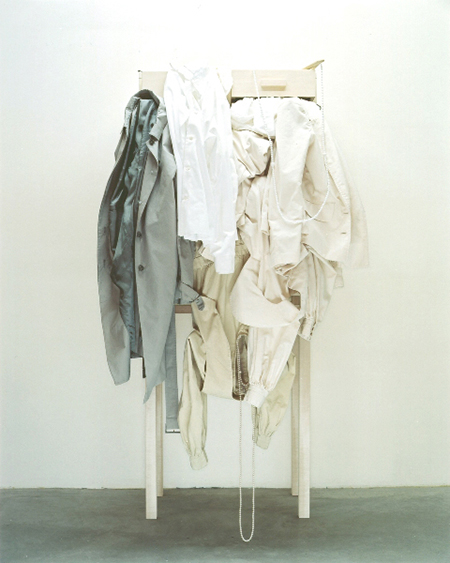
to sleep 2002
Photography by Yukinori Maeda
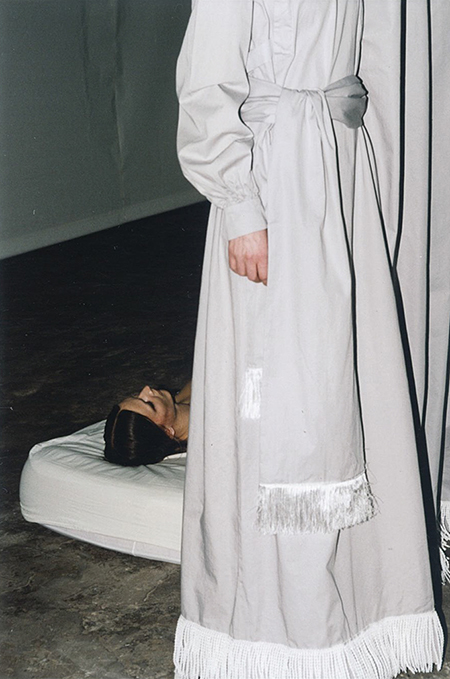
A shadow Necessary for Windows 2002
Show at Palais de Tokyo, Paris
Photography by Yuki Kimura
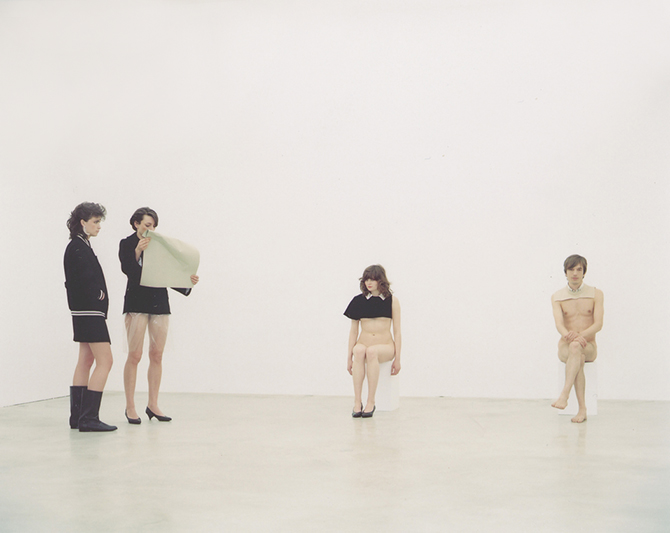
What invisible view should be ~ from some pictures 2003
Show at Cosmic gallery, Paris
Photography by Yuki Kimura
Ready, Set, Go!
Friends venture out to earth carrying their most treasured possession under their arms, and gather together in a promised place.
Between us we call it the “stardust gathering.”
Before being born upon this earth, we always, in this promised place, share our treasured scenarios with one another.
The scenarios are important things that each star creates with their own will.
A masterpiece as thick as a dictionary. A simple one written on a single parchment. A curious thing comprised of prose poetry.
The colorful scenarios of the stardust are all revealed at once at the same timing.
Then in a moment all the scenarios come to connect, become involved with one another, and innocent promises are exchanged.
“I will be born a man.” “In that case, I will be a woman.”
“Let’s meet in 2017.” “At the place regarding the stars and dragons.”
The place that we, right now, are here on this earth.
If you look around you, you will surely realize that everything is connected and involved.
Of course, it does not matter if you don’t understand. Because it’s only something that you’ve forgotten.
The daily lives that we lead.
We feel each and every one with our respective receptors.
So that we can remember what is important, an array of gifts is prepared throughout our everyday.
If we are able to remember the very things that are important to us,
it is indeed possible to remember another one.
To be in time as well as to connect and be involved with the specks of stardust that we live together with right now in this world, and with whom we have exchanged innocent promises.
“I think I might enlist myself with the role of scolding you.”
“Thank you. Then, will that make me dislike you?”
“I don’t know. It’s alright for you to come to dislike me.”
“Don’t be silly. I will never at all come to dislike you!”
The specks of stardust that have forgotten their promises may argue, or come to dislike one another, yet once all is remembered, everything will be a matter to laugh about.
“You, you said that you wouldn’t dislike me.”
“I’m sorry, I’d simply forgotten. That’s strange, I never thought I’d forget.”
“But to tell you the truth, I too had forgotten. I didn’t like you.”
“It’s indeed funny, isn’t it. But thanks to you I was able to quit my job.”
“I see. Then I guess that means that all’s well that ends well.”
It doesn’t matter who you come to like or dislike.
One of the pleasures of earth is that you can freely choose everything.
A play of the stardust where no sense of superiority or inferiority exists.
Every night when we gaze up at the countless stars floating in the night sky, we will surely remember.
We will remember each radiant spark, color, the place where they belong, and the distance of their connection.
In our everyday where various things happen, all and everything is perfect.
Being just safe or just out, are both loving gifts.
Let us together try to reminisce that time and place where we showed each other our scenarios.
Let us reconfirm the innocent promises that we made.
Ready, set, go!
Yuya Kojo
Translation by Kei Benjer
To Be With the Circulating Flow of Water
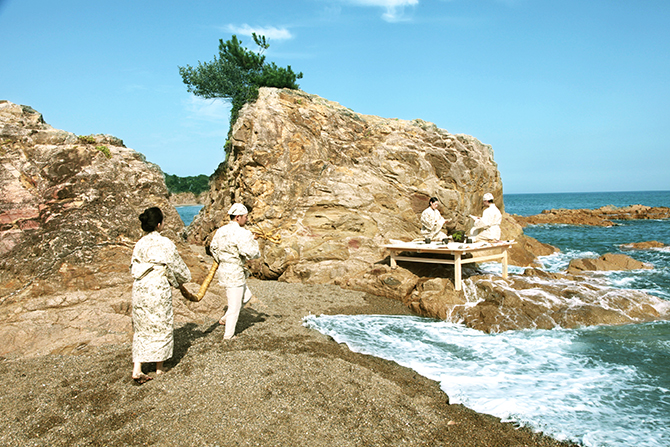
“The current of the flowing river does not cease, and yet the water is not the same water as before. The foam that floats on stagnant pools, now vanishing, now forming, never stays the same for long. So, too, is it with the people and dwellings of the world.” 1
It has been made apparent that there is indeed a beginning to our world, assumed to be 13.8 billion years ago. It all began with a large explosion, and ever since the universe has found itself in a state of cooling while simultaneously continuing to expand. The earth was born amidst this process of expansion and cooling, and life was consequently conceived. Primordial conditions were chaotic, yet differentiation occurred with the passing of time and the gradual decrease in energy, giving rise to a sense of order, and eventually arriving at a state of stability.
Tracing back, one can say that there have been various primordial beginnings throughout the course of history from the primordial beginnings of the universe, the galaxy, the sun, the earth, to that of living things. In the primordial conditions of such systems of all there is always a sense of chaos. The “Omizue” performance that took place on August 19th 2016 on the coast of Kohamacho in Masuda City, Shimane Prefecture, served to express such primordial origins by means of a physical experience. A total of approximately thirty members participated in the ceremony.
*
The ceremony commenced at eight o’clock in the morning. It was a ritual that borrowed from the format of the tea ceremony. August’s morning sun had begun to rise into the eastern sky, its bright light engraving deep shadows on the ocean and land. The guest moved eastwards along the shore from the waiting area, making their way to the sandy beach where the ceremony was to be held. It was a purified space on the beach, surrounded by four boulders. The boulders clearly separated the inside and outside of the space like a barrier. A wooden platform measuring two square meters on each side was installed in the rocky area along the seafront. This room of sorts was referred to as the “Omizuedo” (setting for the Omizue ceremony), and a large sheet of washi paper was laid out to cover the surface within. The ceremony was hosted by Yukinori Maeda and Sumiko Ishii. In each session there were two assistants to the hosts, and three guests. One by one, each guest would take off their shoes, and be seated. The constant crashing of waves against the rocks at times brought a light spray across my cheeks, enabling me to feel more clearly the strong winds that carried across the ocean.
One of the hosts began by explaining the purpose of the ceremony to the guests. He said, “We have prepared for you many blessings that are based on the impressions we have formed during our journeys in Iwami. We hope they will be to your liking.” This was followed by a reading of the “Yama-umi-kawa-kami” poem (p.8) that was written on washi paper. He slowly and quietly opened out the Sekishu-Washi paper that had been crumpled, folded, and placed to the side, allowing the guests to observe the entire process. The washi paper was infused with plants and seaweed native to the mountains, ocean, and rivers of Iwami. One could hear the sounds of the washi paper being unfolded. The paper, held in both hands, was then presented to the guests for a closer look. The washi paper fluttered in the gusts of wind coming in from the ocean. Thereafter, the guests received Japanese confectioneries made with salt extracted from local seawater. This was followed by the gift of water. This was spring water collected from near the source of the Takatsu River, a clear tributary that flows from the Chugoku Mountains into the Sea of Japan. The vessels for serving the water were made from Iwami’s soil. Each participant received one serving of water.
After the guests enjoyed their gift of water, they departed from the Omizuedo. During the ceremony, a dragon made of straw, that had been hanging from the side of the Omizuedo, was immersed in the ocean. The two ceremonial assistants carried the straw dragon out from the ocean and, taking firm, certain steps, walked seven and a half times in a circle. While this was happening, the hosts remained in the Omizuedo and read out a text written on the Sekishu-Washi paper. There words could not be heard, lost amidst the roaring of the sea.
From beginning to end, the surge of approaching waves came crashing in with a deafening roar and the morning light of the August sun, in its increasing brightness, illuminated all that lay beneath it. A solemn atmosphere had permeated the ceremony. A natural barrier of boulders surrounded the site. In this natural setting, a series of ceremonious acts were carried out by human hands from a heartfelt hospitality that symbolically brought together the essence of Iwami and the gift of water. A certain sense of unity between nature, the hosts, and their guests emerged from the sharing all of these elements, leaving one with a sense of awe and admiration towards God.
Before God first proclaimed “Let there be light” and brought about the existence of light, the world had been a place where “the earth was waste and void; and darkness was upon the face of the deep: and the Spirit of God moved upon the face of the waters.” 2 It was a world in which “the young land floated like a tallow on water, drifting like a jellyfish.” 3 It was an experience of delving into nature’s primordial state, which essentially exists as an indifferent entity. The mode of recognition by which words and concepts are used to classify the various elements of nature is something that has dominated our lives through the present day. Our consciousness is indeed deeply immersed in this way of perceiving the world. From mountain, ocean, river, sand, rock, grass, water, sky, cloud, light, wind, sound to scent; hadn’t these entities that were made discrete with words and concepts, been part of a single whole? Were we not ourselves once a part of this whole? And don’t such primordial forms and conditions still persist through the passage of time? This was an experience that provoked such thoughts.
From the words and objects presented in the ceremony, one could discern that this was an attempt to make a symbolic return to primordial conditions and to achieve “the unification of that which is divided.” The “Yama-umi-kawa-kami” poem that was read out at the beginning, started with the phrase “everything was together as one but over time had been divided into two,” and came to a close with, “the mountains, oceans, and rivers come together as one,” repeated by three individuals representing the elements of “yama-umi-kawa” (mountain, ocean, river).
The paper garments called “Yama-kami Kamikoromo” were made with trees and plants gathered from the local region. The “Umi-kami Kamikoromo” were made with paper infused with seaweed, and the “Kawa-kami Kamikoromo” with paper infused with water plants. The “Oto-kami (Sound Paper) / Yama-umi-kawa-kami”, that the hosts of the ceremony unfolded before our eyes, was made with all of these elements.
In addition, from the fact that the “Yama-kami Kamikoromo” was made by a papermaker who lives near the ocean, and the “Umi-kami Kamikoromo,” “Kawa-kami Kamikoromo” and “Oto-kami (Sound Paper) / Yama-umi-kawa-kami” were made by a papermaker who lives in the mountains, one can also see an intention to bring the mountains and ocean together in harmony with one another while simultaneously treating them in a contrasting way.
If we were to recognize that one of the primary functions of a ceremony is to instill us with the sensation of returning to our primordial beginnings, then the theme of the “Omizue” did indeed adhere to this concept. This was also apparent in the intuitive selection and use of the tools for this ceremony.
*
The Iwami region is located in the western part of Shimane Prefecture. The prefecture has a long coastline facing the Sea of Japan, and borders the Hiroshima Prefecture to its south and the Yamaguchi Prefecture to its west. As the name ‘Iwami’ (which literally means, ‘seeing rock’) suggests, the mountainous area extends quite close to the coast. There is very little flat land, and the scenes of waves crashing against the coastal cliffs is impressive. The Iwami Ginzan Silver Mine and its Cultural Landscape has recently been designated as a UNESCO World Heritage Site, and Sekishu-Bashi: papermaking in the Iwami region has also been listed in UNESCO’s Representative List of the Intangible Cultural Heritage of Humanity. In this sense, even from a global perspective it is a region that brims with unique features and a rich cultural environment.
Masuda City, which was the setting for the “Omizue,” is located on the western edge of the Iwami region. The city is in the downstream area of the Takatsu River, which flows from the Chugoku Mountains up north and into the Sea of Japan. It was built on Iwami’s largest plain, the Masuda Plain. Takatsu River has been proven to have the highest water quality among all domestic first-class rivers.
The water served at the “Omizue” was collected in the town of Hikimi, in the mountainous region of the Masuda area. It is a forest region surrounded by mountain ranges reaching 1000-meters in height. The Hikimi River, with its source near the bordering Hiroshima Prefecture, flows to the west side of the town, joining the aforementioned Takatsu River downstream. The gorge formed by the Hikimi River is especially known for its beautiful autumn scenery.
Against the backdrop of its historically rich natural environment, traces of human life dating back to the Paleolithic age from 12,000 to 30,000 years ago have been discovered4, as well as many ruins from the Jomon period. Beyond the river terraces that extend along the Shiso River are several important Jomon ruins such as the Ishigatsubo Ruins 5 and the Mizutanokami Ruins 6. Numerous pottery and stoneware artifacts from the middle to the late Jomon period were excavated from the Ishigatsubo Ruins along with pit-type dwellings and remains of collected stones from the time. Amongst these excavated objects, fragments of Namiki-style and Ataka-style pottery native to the Kyushu region have gained much attention as proof of the exchanges between peoples of the time.
At the Mizutanokami Ruins there are a series of rocks each approximately one meter wide grouped together in a large circle measuring seventy meters in diameter. Here, earthenware and stoneware including religious relics such as Dogu and Doban (dolls and plates made of clay) as well as jewelry like Magatama and Kudatama (comma and tube-shaped beads) have been excavated. A fragment from a bronze dagger-axe that would have been used in rituals in the Yayoi period was also unearthed from the same site. Many similar artifacts have been excavated throughout the northern Kyushu region and are thought to have been made in the Korean Peninsula during the early Yayoi period or else very early examples of objects produced in Japan 7. There is also the possibility that it was brought to Hikimi along with the introduction of rice agriculture to the east 8.
It is indeed meaningful to be able to come close to the actual lives, exchanges and spiritual activities of people from the Jomon era through such remains and relics. When one considers these historical traces, the Jomon elements among the tools used in the “Omizue” and the accompanying exhibition naturally come to rely on actual history itself, further deepening the impressions that they convey.
In addition, the dance of the straw dragon that brought the “Omizue” to a close derives from the folk beliefs of the Iwami region that have been passed down since ancient times. Following the aforementioned Takatsu River upstream, one arrives at its source in the town of Yoshika, located in the Chugoku Mountains. Here, there is a small pond known as Daijagaike (which means, ‘big snake’s pond’), and next to it stands a large Japanese cedar tree with branches stretching extraordinarily wide. Marshy grasslands extend throughout the area. Every June a Shinto ritual is held here to pray for rain. People carry a dragon or snake-like creature made of straw into the pond, submerging it in the water, making it dance up and down, and finally offer it to the cedar tree.
The Wara Ryu (straw dragon) also appears in Omoto Kagura that has been passed down throughout the Iwami region. Omoto Kagura is a Shinto theatrical dance that celebrates the “Omotoshin,” the ancestral god of each district, that has been passed down through generations in the mountainous areas of the Iwami region. In this Kagura, the Omotoshin is welcomed in the form of a straw snake referred to as the “Takutsuna,” and is placed on the altar in its spiraling state. At the end of the Kagura that takes place throughout the night, the straw snake is hung from the canopy and shaken violently. At times it experiences a divine possession, and an oracle is delivered. At dawn the straw snake is returned to the world of the gods, and comes to rest as it is wrapped around the sacred tree9. By tracing the symbolism of the straw dragon of the “Omizue” to these traditional Shinto rituals of the Iwami region, one is reminded of the ways of a world in which God and man intimately, and harmoniously coexist with one another.
*
The format of the tea ceremony is appropriated in order to materialize and symbolically convey the gods in the state in which they had existed prior to their personification. It is an act of communication in its most pure and hospitable form. Here, the distinction between host and guest, or subject and object is clearly apparent, and the genuine purity harbored within the act of communication becomes prominent. In the earliest primordial conditions, the gods inhabited everything that was in existence. Divinity is rooted in the land and the earth exists as an aggregate body of various regions. If one were to take the view that it is only a difference in scale, then one could say that each region, the entire earth, and even the universe are all inherently the same thing. The scale at which one looks at something can create great differences in our recognition. By changing the scale of our recognition and how we consider things in time and space, we are able to see the things that we could not see, and notice the things that we could not notice. If I were to change the way that I look at this vessel that I hold in my hand, I could see that it is the soil of Iwami, an aggregation of molecules, and furthermore, a collection of elementary particles. In this way, looking at an object as simply an object is no longer enough. The very same thing can be said for nature’s constituents such as the mountains, oceans, and rivers.
The act of serving and receiving the organic substance of spring water into the body. The spring water eventually passes through the human body into nature, and continues to circulate around the earth. Where does the water served come from, and where does it go? The water that is within our bodies for a fleeting moment in the midst of this great cycle is at the same time the water from the ocean that extends before our eyes, the clouds that hang in the vast sky, the water that flows through underground streams, and the water of the rivers that connect the mountains to the oceans. It is the rain that falls on the earth and it is the water vapor that is contained in the atmosphere.
The earth is filled with the richness of water. It was in this water that living beings with organic structures were miraculously conceived. One wonders at how mankind, as one such living creature, senses beauty in the glitter of sunlight that is reflected on the surface of the ocean. And one wonders at being able to experience this sensation together with others. The reason that we find beauty in the evening sky and oceans set ablaze under the setting sun is perhaps because we, in that very moment, sense the passage of time and ephemerality. We can witness with our very own eyes that this very moment can only exist precisely at this moment in time. If we were to consider everything from this perspective, then all things are indeed precious.
The day comes to an end, and the sun rises again the following morning. Although time appears to follow a cycle, it is never the same. Knowing the process from the beginning of the universe through to our current time, it is clearly evident that time always and only progresses forward. It appears to repeat in a cycle, yet in reality it only happens once. Its everlasting providence is that it is always in flux. It is also a known fact that this planet that was born 4.6 billion years ago will come to end its existence in another 5 billion years with the extinction of the sun. Everything is part of the same universe, and everything is always changing.
Kenji Mukunoki (Shimane Art Museum)
English translation by Kei Benger
Notes
1 Kamo no Chomei, Hojoki, Iwanami Bunko
2 “The book of Genesis,” The Holy Bible, Standard English Version
3 Kojiki, Iwanami Bunko
4 Excavation Report of Shin Makihara Archaeological Site, Hikimi Town Board of Education, 1987
5 Ishigatsubo Ruins, Hikimi Town Board of Education, 1990
6 Mizutanokami A Ruin / Nagaguro Ruin / Shimomasanota Ruin, Hikimi Town Board of Education, 1991
7 Cited above in Note 6
8 The History of Shimane, Yamawaka Shuppansha Ltd., p.43, 2005
9 Kagura in Shimane: Performing Arts and Ceremonies, Shimane Museum of Ancient Izumo, 2010
Photography by Yurie Nagashima
The silent furnace of the unknown gives birth to a new light.
Vol.1
This year marks 20 years since Cosmic Wonder was founded.
Yukinori Maeda who moved his studio and residence to Kyoto’s Miyama region this winter to “establish a Ryugu” within the village of thatched roof houses, mentioned how he had been rushed off his feet the day before the interview, busily engrossed in shoveling snow from morning to dusk. What I saw in the Skype screen beyond the house’s traditional sliding windows, were rows of pine trees covered in a deep veil of snow. Between the trees were the first traces of blue sky that had experienced in several days.
On the other side of the Skype screen, Maeda proceeded to speak to me about the photography book that he had taken in New York 20 years ago, his first show at Paris Fashion Week, as well as his creative activities and attempts to pursue the world of the mystic and divine. From time to time throughout our conversation I had captured glimpses of Cosmic Wonder’s sharply refined spirit that set out to open up new horizons that have never been explored before, and the fluctuating thoughts that drifted here and there between the past, the current, and that which lies beyond.
“The silent furnace of the unknown gives birth to a new light.”
N.H: Today I would like to begin by reflecting upon the first 10 years of Cosmic Wonder’s activities. You had initiated Cosmic Wonder soon after graduating from university in 1994, yet I believe its actual founding was in 1997.
Y.M: I started Cosmic Wonder with my circle of friends after graduating from an arts university with a degree in architecture. At first we were really just trying to find our way. None of us had experience of working before so we were going about doing things by our own means. By 1997 we had determined our sense of direction, and thus made it into a company.
The dress attachable a wall 1999
We don’t have need walls in our hearts anymore.
Where did the walls in our hearts go?
We attached a wall to the dress.
It’s better to attach a sorrowful wall to the dress or show.
And then be free!!*
N.H: Cosmic Wonder’s first work was a photography book entitled, “The dress attachable a wall” (published November, 1999). At the time there had only been a few people in Tokyo who were aware of Cosmic Wonder’s activities, yet I vividly remember seeing the photography book being in a large display in On Sundays. Could you please tell me how this publication had come about?
Y.M: I wanted to produce “clothing that is not clothing as we know it, but is instead an object of creation.” The intention had been to depict situations of wearing such clothing in the everyday through the context of this photography book. In making the publication I was introduced to members of a New York band called “Actress.” I asked them to wear the dresses with the attachable walls, and then photographed them in their daily lives in New York.
N.H : Four models were photographed over a period of four days?
Y.M: Yes, although the band no longer exists.
N.H: Did you take the photographs yourself?
Y.M: Yes.
N.H: At the end of the book the four models are asked the question, “how was it like wearing a dress with an attachable wall?” I thought it was interesting how each one of them had responded in entirely different ways. The answers ranged from, “It was amazing! The walls were much warmer than I thought” and “They really got in the way” to “I took it off at the end of the night. It got in the way of my band practice” and “It gave me a sense of security. Before wearing it I had felt a sense of sadness, but once I tried it on, I felt amazed.” In the early years of Cosmic Wonder, you had two separate lines. There was a collection line that you presented as artwork, and there was Cosmic Wonder Jeans as an everyday wear line. I recall that “The dress attachable a wall” was part of the collection line. How were the dresses with the attachable wall actually made?
Y.M : They were created through a slightly unusual method. A piece of felt that was made to look like a wall was needled and integrated into the see-through body cloth. The body cloth had been left in its rough-hewn state, and resin was applied to the edges to prevent fraying.
N.H: I would further like to ask you about this aspect of the “wall and dress becoming attached.” In Cosmic Wonder’s early years, this idea of “something attaching itself to clothing” seems to be a recurring theme. At the time you had explained this as “combining things that don’t usually go together in a manner like white magic,” and thus attached things to clothing like walls, handkerchiefs, broken electrical and lighting appliances, curtains, and furniture such as curtains, drawers, and coat hangers. These are all familiar objects that we find in our daily lives. From there a sense of beauty with an unexpected air of tension is born, however what actually creates this scene is clothing that can be worn and is in fact more wearable than meets the eye, further instilling those who look upon it with a mysterious experience. Where did this idea of attaching surprising yet familiar objects to clothing come from?
Why had you first decided to attach a wall? Did it have anything to do with the Berlin Wall?
Y.M: First of all, the idea of attaching a wall to a dress had initially been inspired by my desire to give a sense of what’s between the body and something else, or what I may call, the existence of the aura. I wanted to channel my interest towards the spiritual world into something that I create, but I didn’t exactly know how to go about doing this. When I look back on those times, I feel that I perhaps had been making work while thinking about the relationship between the familiar things that I see in my surroundings, or in other words, the everyday, and clothing. I may have found myself envisioning something extremely vast within the context of something very small.
Steamer 2000
Aboard the steamer was a lone woman.
She had a large sharpless bag, which she carried the bag around with her.
She answered that it was her child, as well as a life preserver.
If the ship were to go down, her child would float in the water.
The other passengers thought the woman was very strange.
Did she harbor some terrible loneliness or anxiety?
But actually, the woman seemed more positive than anybody else on board.
Her comical, ridiculous appearance was her way of resolving the loneliness and anxiety occasioned by her ocean voyage.*
This collection was created by her, who is free and emotional in the truest sense. She says: “this is my marine look” *
Steamer Doll 2001
The woman from the steamer was featured in a TV documentary program. She had disembarked from the vessel and was now living in a small country village.
“I don’t like country people,” she said.
“They see me and ask what I’m carrying. They try to feel what’s in my bag, and the worst of them even try to grab it away from me.”
Yes, she was still carrying that big bag.
“But I love this landscape, and I’m fond of my good-luck charm. I feel so calm and happy, and it’s all thanks to this bag.”
A girl who had seen the woman on this program copied her by filling a plastic with air and tying it to her skirt.
Wearing a cynical smile, she murmured: “Can this really make you happy?”*
N.H: “Steamer” is a work that was presented in 2000 on the occasion of Cosmic Wonder’s first ever show at Paris Fashion Week. There were a lot of decorative elements involved and it had quite a different impression to your current works. With “Steamer” followed by “Steamer Doll,” there had been two consecutive seasons that conveyed a similar sense of direction.
Y.M: The models wore high-heels and looked like dressed up old women (laughs). They were like clothes for people who usually don’t pay attention to fashion. Back then, every time I announced a new collection it would be accompanied by a short poetic story, and at this time it had been a narrative about a ghost-like woman. She was the kind of nameless person who you’ve either met somewhere or who you may encounter in some place. I wanted to do something that you might do with found photographs, but in this case using clothing.
N.H: Confronting the abrupt encounter between heterogeneous entities?
Y.M: A sense of wholeness that evokes one to imagine the ambiguous areas.
N.H: What did it mean for you to take part in Paris Fashion Week? Until then you had centered your activities in Osaka, publishing “photography books” and presenting “photographs and video works.”
Y.M: I had decided to create a selection of new works twice every year. I think it was important for us to a have a place where we could present them.
Conversation with Electrical Appliances – Broken Radio, Worn-out TV…. 2001
Dresses for decorating broken radio or worn-out TV, giving a new value to things that have lost function and been forgotten.*
N.H: Since “Conversation with Electrical Appliances- Broken Radio, Worn-out TV…” that followed, you seemed to venture more towards an installation-based approach. I feel that “Conversation…” had indeed served as a turning point of sorts for your practice.
Y.M: Yes. From around this time I had begun to think more strongly about notions of “space” and “art.” What kind of effect does it have on the space when it is inhabited by people wearing clothes? Contemplating a cohesive sense of beauty that involves not only the clothes by also the space is something that persists to this day. At the same time, in addition to the people who come to see the presentation, it also concerns an interest towards how the people who have purchased the clothes appear to look like in the space that they are in.
N.H: I see. I recall that you have continuously engaged in the act of documenting the space in Paris where you have presented your collection, taking photographs of scenes when the model and audience are absent. In this respect, from early on you have held this awareness of “the space itself also being the work.” In retrospect it seems like a natural thing for you to do, but I feel that there must have been a strong sense of will behind the very act of taking these documents in the midst of those busy days in Paris. It was a time, in which the theme of art and fashion had been enthusiastically discussed, and thus in Paris Fashion Week many new collections were presented in the form of installations rather than fashion shows.
Y.M: That had indeed been the case, yet there were rarely any presentations that gave you the feeling of being fashion and art at the same time. My understanding was that you could not call something art simply because it embodies a visually surprising form. I indeed thought that you could create something really interesting if you could take a step further to pursue fashion in the context of its interest as art.
*The poetry texts are the concepts for each collection that were written at the time.
January 17, 2017
Nakako Hayashi and Yukinori Maeda
English translation by Kei Benger
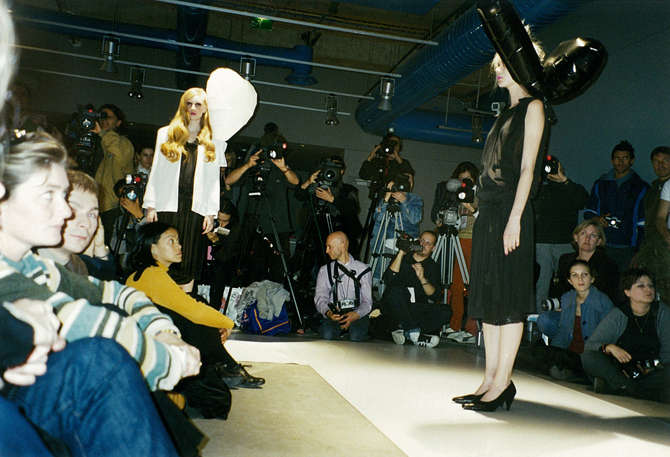
Steamer 2000
Show at Centre Pompidou, Paris
Photography by Nakako Hayashi
A Story of New Garments
− Reportage on wearing the garments of COSMIC WONDER
1
In my room overlooking the lush green mountains of Gifu,
Feeling the breeze from the river gently against my cheek,
I savor the touch for example, of COSMIC WONDER’s
Organic cotton circle T-shirt.
Its round form.
Beautiful lightness.
Material imbued with the soft light.
Each time I pass my arms through its sleeves,
The ancient times and the future
Cross and overlap across my body,
And a “new feeling”
Enriches my mind.
COSMIC WONDER’s garments,
In their entirety,
Embody the sensations inborn but completely forgotten
That we trust and love our whole selves,
And signs of the sensations we would experience in the future.
The moment you see them, your mind gets free.
The moment you wear them, your body feels great.
Then your sense of time and space only concerns the “here and now,”
And your new self comes to emerge.
(The new self is not unknown to you,
Because She / He is your true self,
Sleeping within you ever since the ancient times.
That is the yourself in whom
The divinity continues to glow.)
The overwhelming freshness of your new self
Makes feelings of joy flow from the bottom of my heart.
2
The experiences of your new self,
Produce the inherent rhythm of the universe,
Like when you use an ancient calendar.
This world is discontinuous, invisible, irrational, and non-dual.
It is a dream, invisible but visible,
That we modern people almost forgot.
As soon as we know it,
As if our whole body both inside and out
Becomes filled with beautiful water,
We understand.
(Actually, we have always known that sense −−)
3
When COSMIC WONDER’s garments
Made in a mountain village
Come to find themselves
In another little town surrounded by mountains
This World finally begins
To ascend into the next realm of consciousness.
COSMIC WONDER’s garments
Are with this new consciousness
And create a new world.
Today, now, and at this very moment.
The way the softness of the light streaming through the shoji,
Brings forth a great effect
Upon the body, mind, and soul of human beings.
We now, return to nothing.
With the particles of light serenely released from the water
August 8, 2015
Millet Hattori
English translation by Kei Benger
Trees and People
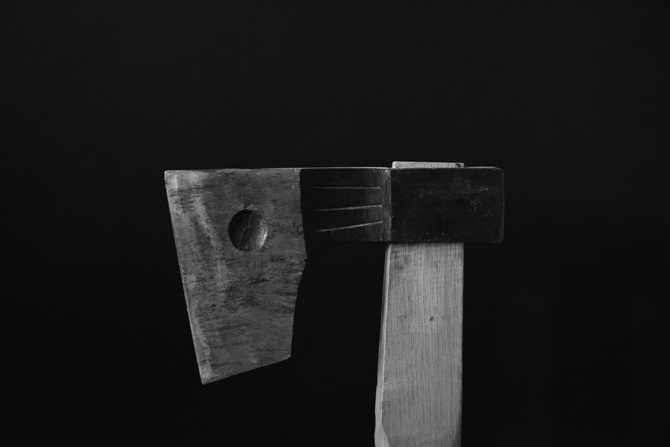
In Japan’s mountains there had once been people known as Soma.
Soma are those who make a living by entering the mountains and cutting down trees, and further transporting the timber.
Unlike our current day that has seen the progression of mechanization, such work that dealt with confronting the harshness of nature and engaging with enormous trees purely by means of human strength, wisdom, and horsepower had once been extremely dangerous.
These however, are things that are now difficult for us even to imagine.
For such work of the Soma, there is an essential tool called a ‘Yoki.’
The tool is the same as what one would generally recognize as an axe, yet the people of the Soma refer to it as a Yoki.
A Yoki always has three lines engraved on its left side, and four lines on its right side.
A tale states that the four lines on the left side portray the four ‘Ki’ (spirits) of earth, water, fire, and wind, which itself became the origin from which the word Yoki was derived.
Furthermore, it is said that the three lines on the right side represent ‘Miki,’ or in other words, ‘Omiki’ (sacred sake).
When cutting a tree down the Yoki is first placed leaning up against the tree with the Omiki side facing the bark, and the Soma engage in a ‘Kashiwade’ (clapping of one’s hands in prayer) before commencing their work.
Some feeling of inquiry had lingered within me however.
Was this really all that there is to it? It was at such a time that I had coincidentally, and somewhat abruptly come to learn of two things.
I had learnt of a snowy village in the deep mountains of Akiayamago in the Nagano prefecture, where the Soma revere the numbers of three and four.
It is said that they never enter the mountain on the third and fourth days counting from their zodiac.
Nevertheless, the Soma themselves do not know any more than the fact that this is something that had always and naturally been practiced.
Elsewhere it is mentioned that in the way of the yin and yang, three is an odd number that signifies the yang, and four is an even number that signifies the yin.
I was therefore told that the opposing relationship of the yin and yang are present within both sides of the Yoki.
It was here that I sensed something of a connection.
Yin and yang are different things, yet are always together.
From its very nature as a tool the Yoki is something that divides one thing into two, yet by dividing it into yin and yang one could say that it serves to create a division while simultaneously forming a connection.
In terms of felling trees then, the Yoki perhaps means to form a connection between the side that is felled and becomes timber, and something (a memory of sorts) that lies within the tree trunk that has been cut.
Do the Soma not enter the mountains in reverence towards those numbers and in feeling a sense of divinity from them?
What if each and every tree that is distributed as timber still persists to be connected to the mountains?
What if these people known as Soma engage in their work under the pretext of such a wish?
One questions whether our treatment of trees should really remain as we see it now.
March 6, 2016
Masaru Kawai
English translation by Kei Benger
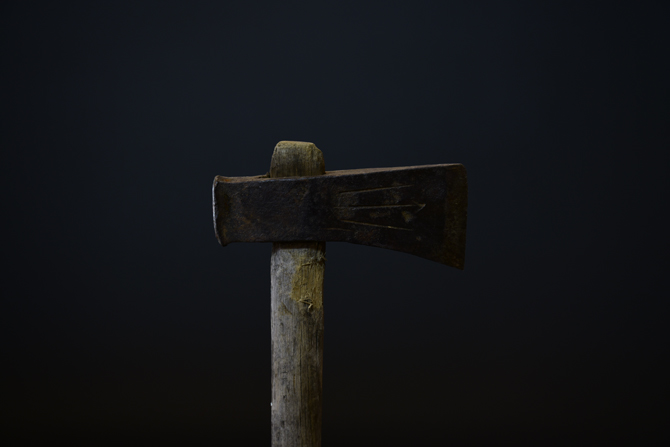
An Experiment in Divinity
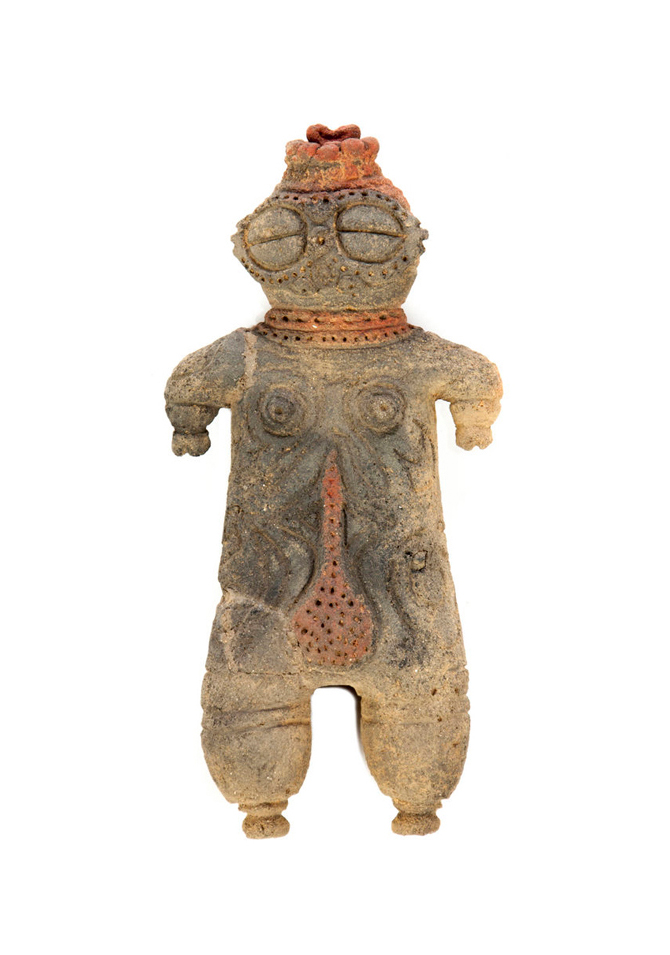
Let ourselves make an experiment
That does not require white coats or any tools.
All we need is our very own bodies.
◎The Experiment
When we return to the original physical condition we were born with, we are in the best of our health
When our level of consciousness rises, we see only the pure consciousness of things
When we are in our own true colors, our most wonderful charm is released
Those who live only with Prana instead of food and drink, exist as Light-eaters
Strong, delicious crops can grow without plows, pesticides, and fertilizers
Ultraviolet rays, infrared rays, and all other kinds of visible light are made of love
We feel reassured when others allow us to live in our own skin
Everything is made of the same thing
These are some of the things that I have heard and have actually seen
Now is the time to experiment
To lead our lives believing in these things
Or to live in doubt about them,
Let ourselves consider which is more pleasant
Now choose from the above
Several sentences that you like
And try to savor them one by one
Believing that such world is real–
Or not believing that–
Now close your eyes…….
Engross yourself in such thoughts
Until your mind gets tranquil
Within ourselves
And
Everything, there is a sense of divinity
Everything is part of a single divinity,
And one of the results of the experiment
‘Of being born from the light’
Exist within our physical experience.
(Note* Most people have in general,
Led their lives unaware of the divinity that rests within them
Yet now, we have come to recognize this divinity
And the gate of a new time has opened, allowing us to live consciously)
Both before and after the gate’s opening
COSMIC WONDER’s garments
Have held an extremely rare presence imbued with an energy
That make us aware of the sense of divinity and we make it glow,
Once we pass our arms through the sleeves of such garments
These garments are, the light.
Just as you, are the light.
Just as everything, are born from the light.
Has come the time, where the light is ubiquitous.
Passing through the gate of a new time
Soaked in the light of the water
August 6, 2015
Millet Hattori
English translation by Kei Benger
Photography by Ai Nakagawa
A Document of Memories
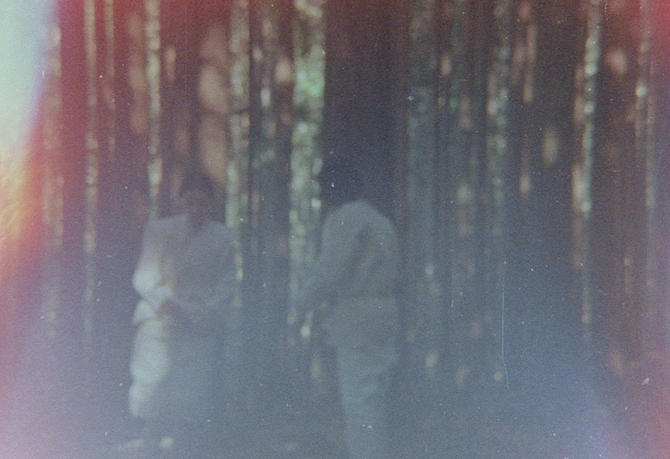
On that particular day when Yukinori Maeda had informed me about the ceremony, it had never occurred to me that I would be able to visit. There are no trains or buses leading to that place embedded deep in the mountains of Kyotanba. I was in Kyoto at the time on Monday, March 30th, when I was told that ‘Kamino-hikarino-awa Water Ceremony,’ was to take place in that setting as a creative gathering by Cosmic Wonder and ‘Kogei Punks Sha’ –an artistic unit by Yukinori Maeda and Sumiko Ishii whom presides over gallery Hakuden, a sanctuary of sorts for ceramics and handcraft. I had heard of this news whilst having lunch in an earthen wall room surrounded by bamboo trees, within a restaurant that served dishes reminiscent of Korean cuisine. Despite nestled in the heart of downtown Kyoto, Maeda had mentioned to me that he “felt at peace” whenever he dined there. At the time of our conversation I had gained the impression that aspects such as the specificities of the ceremony, details regarding the schedule, and measures of how to perform the ritual of the water ceremony, had only been decided upon vaguely. It was precisely four weeks later from that day, on April 27th, that Yukinori Maeda, Yuki Kato, a culinary artisan of vegan and native herbal cuisine in Kyoto, and myself, had returned to lunch at this restaurant. However on this occasion we were not alone and were in the company of Miyako Yasuda, an individual whom founded Cosmic Wonder with Maeda and currently lives in the Miyazaki prefecture, Yurie Nagashima whom had been invited from Tokyo to photograph the Water Ceremony held on the 26th, myself, and Hikotaro Kanehira whom likewise had visited from Tokyo to participate in this event, and Mitsuhiro Okada who had joined us from Kyoto. Nobuhiro Shimura whom had documented the Water Ceremony on film had already returned to attend to some work in the Yamaguchi Prefecture where he currently basis his practice, and thus had been absent from our gathering.
Each of us had spoken about the extraordinary event that had taken place the day before, as well as the various people we had encountered there. gallery Hakuden, a small exhibition space and store run by Sumiko Ishii whose husband works as a potter, was surrounded by fresh green nature, imbued with the scent of early spring. The gallery and the couple’s living space, the open space that surrounded husband Naoto Ishii’s kiln as well as the cedar forest in the mountains behind it, had all become a stage. People dressed in garments made of white paper had suddenly appeared on that particular day, and as if partaking in a childlike play, had realized a performance concerning paper, the gods, water, earth, and light, that memorably depicted the presences of beautiful elements that we engage with in our daily lives. The handmade sweets and handcrafted Japanese paper were both concerned with matter derived from the earth, and were intimately related to nature. When we were invited into the depths of the mountains and sat on a white sheet of paper to experience the dazzling course of events of the “Water Ceremony” that unraveled before our eyes, each and everyone of us had realized that these elements were not only handcrafted through the bare and honest efforts of human hands, but at the same time had existed on the very zenith of a new form of creation.
I had participated in the “Water Ceremony” in hopes to write a short text to contribute to Elein’s Les Chroniques Purple, however I was soon assured that what I had experienced was not something that I could simply describe within the confines of a few paragraphs. In contemplating on how best to convey my thoughts, I had walked the streets of Kyoto on my own before the luncheon the following day. On my stroll I observed that the city was crowded with an array of two-story Machiya (traditional town houses) that had been modernly converted into Fashion boutiques –a sight particularly distinctive to Kyoto. Small retail stores aligned the streets, presenting their respective arrangements of driftwood and Mingei (folk craft) goods in entrances and windows in an appeal to portray a harmonious relationship with nature. Amidst this fleeting moment of time before the stores opened, I imagined the vibrant bustle of the downtown district, which would soon be full of people. At the same time, my thoughts had drifted to recall the landscape of the Miyama region where Maeda anticipates of relocating to half a year later, as a place that fulfills his ideals. After the “Water Ceremony,” we drove for an hour before sunset to visit the village of Miyama that was to be the setting for Maeda’s next evolutionary step.
From one range of mountains in Kyoto to another, we drove through the lush green scenery to arrive in a village surrounded by mountains. A small cluster of thatched-roof houses were scattered throughout the village, and one could also see the flow of a clear and bubbling stream. The sun was beginning to set. The village seemingly appeared to preserve Japan’s old and traditional style of living, and it was here, in this very place, that I had contemplated Cosmic Wonder’s future way of life and production in the context of the 21st century and their courageous decision to take this step, as well as capture a glimpse of the “Punk” spirit of “Kogei Punks Sha,” that through its name illustrated an endeavor for unsurpassable beauty.
I do not think that Cosmic Wonder’s radical profundity has ever really been understood simply as it is. Not now, or ever before. The world that they pursue is one that requires hard work from both a physical and psychological perspective, and as such I know that various talented individuals whom wish to become residents of this world are present within Yukinori Maeda’s surroundings as if all belonging to a single family. I myself have been a resident of this world for over 10 years, and thus I understand most of what it entails. I appear not to comprehend, yet at the same time I understand. One thing that is certain, is that 15 years ago both them and myself had been looking to the outside of the country. Now, our eyes are shifted to look towards Japan and its origins. What leads us there above all, is the pursuit for beauty within our everyday lives. It is simply a matter of honestly following what awaits us at the cusp of our endeavor. It is the sensation of living in the current, as residents of the 21st century.
Nakako Hayashi, April 28th, 2015
English translation by Kei Benger
The original text was published on Les Chroniques Purple on June 3, 2015.
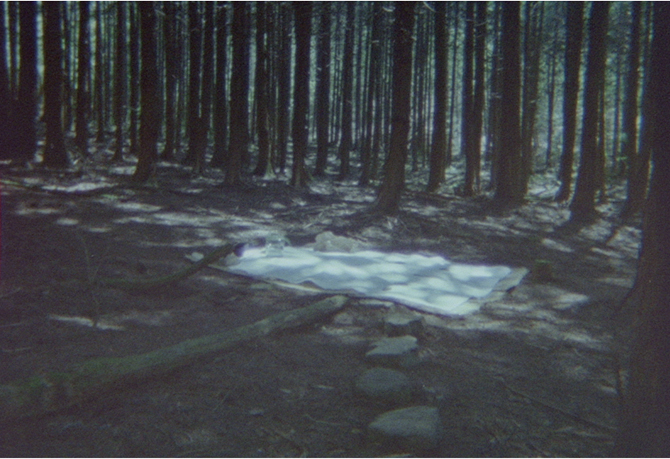
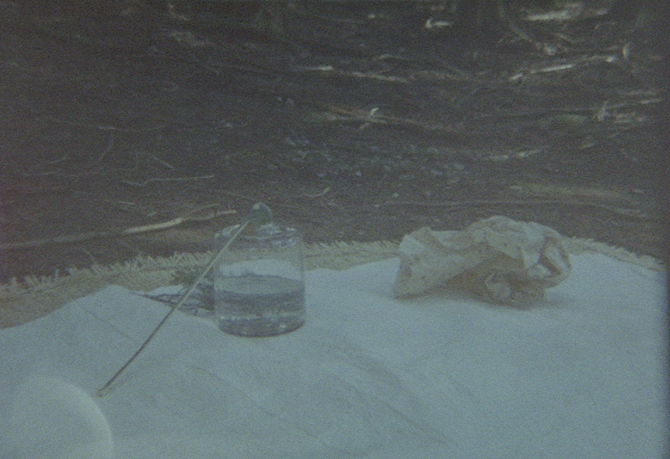
Film still by Nobuhiro Shimura
COSMIC WONDER with Kogei Punks Sha / The Kamino-hikarino-awa Water Ceremony was performed on the 26th of April, 2015 as part of the exhibition “MIERU Kami“.


 Facebook
Facebook Twitter
Twitter